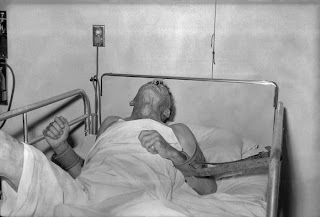|
|
Rabies is a deadly virus that attacks the CNS (central nervous system) and causes acute encephalitis. It is transmitted from animals to humans (zoonotic), most commonly by animal bites - although, there have been cases of humans becoming infected in bat caves after breathing in the air. Rabies infection is nearly always fatal unless prompt treatment is administered before symptoms begin.
Infected people who do not receive post-exposure prophylaxis (preventative treatment after being exposed to the virus) will experience fever, myalgia (muscle pains) and headache, which eventually progresses to brain inflammation, seizures, confusion, paralysis, coma and death.
As soon as the virus reaches the nerves it is incurable. That is why any suspicious animal contact should be treated immediately with RIG (rabies immunoglobulin) injections, antibiotics and rabies vaccine. The incubation period for rabies - how long it takes from initial infection to the onset of symptoms - is usually about 4 to 8 weeks long, in some cases as little as one week and as long as a whole year.
Over 55,000 people die from rabies worldwide annually, 95% of them in Asia and Africa. Most human deaths occur after a dog bite, between 30% and 60% of them are children aged less than 15 years. In the majority of cases, these bites go unreported and are unrecognized by their parents and health officials, resulting in a much higher risk of complications and deaths among children, compared to adults. It is likely the total number of deaths in many parts of the world is much higher than official estimates (we do not know how many undiagnosed deaths there are globally).
According to Medilexicon's medical dictionary:
Rabies is Highly fatal infectious disease that may affect all species of warm-blooded animals, including humans; transmitted by the bite of infected animals including dogs, cats, skunks, wolves, foxes, raccoons, and bats, and caused by a neurotropic species of Lyssavirus, a member of the family Rhabdoviridae, that has tropism for the central nervous system and the salivary glands; inhalation infection possbile (aerosolized virus in bat caves, attics). The symptoms are characteristic of a profound disturbance of the nervous system, excitement, aggressiveness, and madness, followed by paralysis and death. In animals, clinical signs are variable, and sometimes drooling and tongue paralysis are the only signs. Transmission of the virus can occur before clinical signs are expressed. Characteristic cytoplasmic inclusion bodies (Negri bodies) found in many neurons aid rapid laboratory diagnosis.
Related Posts







